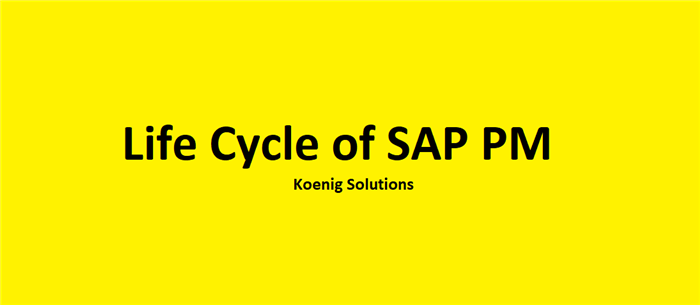
Through unified data processing, SAP software enables diverse organizational functions with a cohesive perspective of rationality. This encourages companies to effectively control dynamic business operations by rendering it convenient for employees in various divisions to seek real relevant data. As a result, companies can boost workflows, boost operating performance, maximize performance, increase customer service – and subsequently expand profitability.
In this blog, we have emphasized the life cycle of SAP PM. How it is done, what are the steps/processes involved in companies adopting SAP PM? It mainly includes Notification, Catalog, and work orders, which are explained below.
Talk To Our Counselor
Life Cycle of SAP PM
The full task order cycle of the SAP system encompasses notification, work directives, scheduling of work, selection of supplies, clarification of fulfillment (presumably including the Cross-Application Time Sheet (CATS), arbitration, and compliance of the work order. The cycle can expand to the assessment of constructive maintenance, such that pragmatic care can be designed to eliminate the number of reactive maintenance. While, feasibly stating, it is appropriate to use work requests without notification or notifications without work requests in the Plant Maintenance system to disregard either means an insufficient knowledge. Notifications may sustain qualitative statistics, such as necessarily imply, which may help prevent maintenance breaches. Job orders retain the integral connectivity of other configurations, including cost statistics.
In general, the structure between notifications and work requests includes a mechanism for validating the work permitted. Establish, along with control and finance professionals, how work requests are to be fixed. SAP course encourages work requests to be exchanged on several participants, such as cost centers, systems, internal demands, other work requests, and so on. If the infrastructure were delegated to the specific cost centers, for example, the work requests developed for that system would, by inference, cover those costs.
ALSO READ : Learn All About SAP Modules in India
Notification
notification in the sap framework is usually used to indicate to anyone that any work is necessary, is demanded, or has already been conducted. these common uses explain the three primary notification forms for pm, while other types are applicable for qm (quality management) and cs (customer service), formerly sm (service management). following the enhancements listed above, notifications capture and collate statistical relevant data and experience on the things against which they were obtained. however, the infor mation does not hold any budget description and has no direct assimilation with other modules.
Notification of a dysfunction review is, as the name implies, a report that system failure has taken place. Usually, a fault report is used where it may be essential to record detailed analysis descriptions, such as mean-time between fails or mean-time-to-repair. The connected piece of equipment may be genuinely delayed, or its output may be affected. Notification of a repair order is commonly used to query maintenance work on a component of infrastructure that may work well, but the technician of which may, for example, see a possible problem. A task log notice is usually used to chart work that has already been executed to restore the equipment's full detailed history.
Catalogs
in the sap scheme, catalogs distribute uniform rules for accidents, damages, events, etc. the advantage of using uniform commands and specifications regardless of allowing free-form representations is that when the material is articulate d, it is simpler to see how many times a particular situation has existed with a specific piece of equipment during a given duration and how many times each corrective operation has been done to fix the same. further testing helps a single vendor to document troubles if the manufacturer's database is accumulated for the equipment. it would be complicated, at best, to collate such information in an accessible structure without design code.
You May Also Like: SAP PM - Overview
Work Orders
The task order in the SAP method is usually used to set up the desired work, apportion the work to staff that implements the relevant work, measure labor, material costs, and supervise the task's accomplishment. A series of actions (or operations) can be listed in the work order. Workforce and resources that will be expected to fulfill the process are outlined in business order when it is in the preparation cycle. This will compensate for the predicted workforce and resource costs. If intended supplies are collected individually from work orders and are preserved in inventory, the work order would establish a booking for those resources.
Conclusion
In this blog, we have shed up the light on the life cycle of SAP PM. The above-given context is based on how the whole SAP PM cycle is carried out in most companies. It is mainly segmented into the three main processes: notification, catalog, and work orders.
Talk To Our Counselor







COMMENT